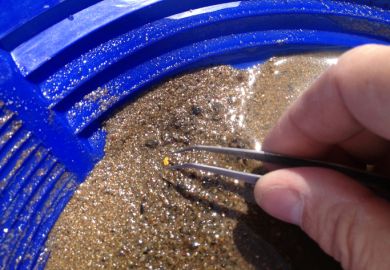Is the painting of pictures a uniquely human activity? Are ape pictures meaningful or thoughtless doodles? Biologist Desmond Morris made us aware of ape paintings in his 1962 book, The Biology of Art, which was written from the biological viewpoint and stressed similarities between apes and humans. Thierry Lenain takes the other tack, starting from art, and concludes that the differences are great.
This book may be weak on science, but it does have amusing and insightful stories from animal painting history. These include apes as subjects of ironic or humorous human paintings, especially by 19th-century painter Alexandre-Gabriel Decamps. One artist, down on his luck, made a comeback by painting in public wearing a gorilla skin.
It was not only apes that created pictures or helped human artists. In a competition in 1806, the Japanese artist Hokusai "unrolled on the ground a long roll of paper and painted it with big blue hoops. Then he took a cock, dipped its feet in red paint and made it walk across the paper. His audience at once recognised a river studded with red maple leaves in autumn". This introduces the major issue of how much do we, as human observers, create meaning or at least some aesthetic significance in ape doodles? This can indeed be asked of human abstract painting, but it is central to considering whether apes paint with some kind of "artistic" intention. An acceptable answer would require carefully designed perceptual experiments. We know human vision is actively constructive, which is obvious from seeing animals and so on in ink blots, and finding patterns of tree branches beautiful. So we need evidence that ape paintings are or are not more cognitive than ink blots and trees. No clear evidence is given either way. It is, however, interesting that some apes do get involved in "painting" and stick to the picture area like real artists. They have to be introduced to the materials and given the idea but so do children.
If "art" implies intention to communicate, this might rule out ape painting at the start, especially as there is no evidence of recognisable representation of objects or scenes. What apes do is to create what to us are quite attractive patterns, but, of course, there are plenty of mindless patterns in nature. An experiment to test whether apes are concentrating on their drawing or painting might be to introduce a short delay electronically between movements of the brush and the appearance of marks or lines on a screen. When humans concentrate, they find it impossible to draw or even write their own name when the picture or writing is delayed by half a second or so. If ape drawing is similarly disturbed, we might at least believe they are trying to be artists.
Richard Gregory is emeritus professor of neuropsychology, University of Bristol.
Monkey Painting
Author - Thierry Lenain
ISBN - 1 86189 003 6
Publisher - Reaktion
Price - £14.95
Pages - 207



